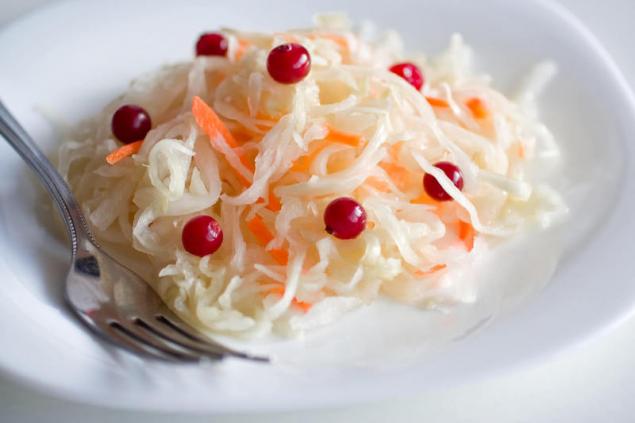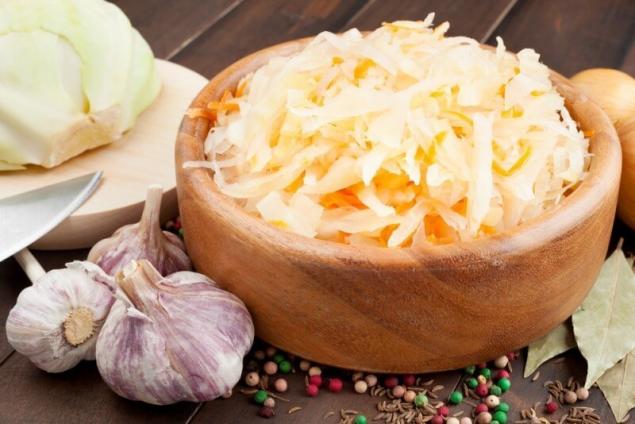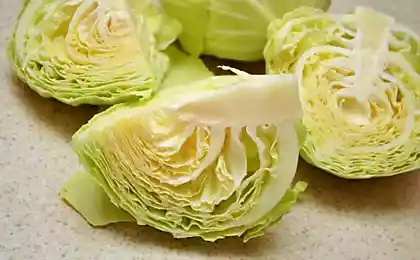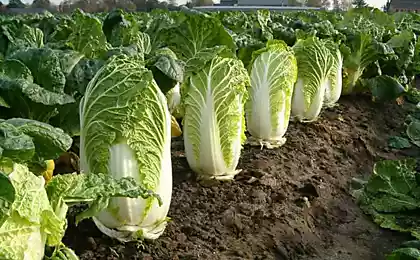1009
How to make salt-free sauerkraut
Sauerkraut and fermented vegetables in General — a great probiotic. What does it mean? That properly fermented vegetables that help to normalize intestinal flora (after antibiotics), treat and stimulate the immune system.
Scientists have found that sauerkraut, the degree of its beneficial effects on the human body, far superior to most artificial species of probioticscreated through the latest medical technology – including because it is easy to "get" to the bottom of the intestine, while probiotics are often artificial "die" along the way.

The fact is that the yeast creates a favorable environment for reproduction of beneficial lactic acid bacteria that live on the leaves of cabbage (especially on the outer leaves of cabbage grown without “chemicals”). In its natural form by eating a head of cabbage, people will get a relatively small amount of data bacteria. However, the proper duration time period of the leaven of this amount would be sufficient that the product was a real probiotic. "Kislomolochny" is not that bacteria can only live in milk — and the fact that they produce lactic acid, eating carbohydrates in milk sugar or sugars of vegetables.
It is proved that even in the condition of scarce food resources sauerkraut allows you to maintain immunity at a proper level, and allows you to stay healthy even under the most severe weather and the spread of many epidemics.
The amount of vitamin C in sauerkraut compared to fresh, grows several times (some sources say that in 20!), contains many other vitamins, especially B group (more specifically, lactic acid bacteria, which multiply in the cabbage during the fermentation process, for us to synthesize these vitamins), anti-ulcer factor "vitamin U" (which is found in cabbage), trace elements, minerals...
Fermentation is good for the fact that the bacteria are doing the preliminary work, "partially digesting" foods and making them more digestible for humans (as is the case with milk in the first place: that's why fermented foods are much easier to digest than whole milk).
On sauerkraut sailors were saved from scurvy. The assurances of James cook, that sauerkraut has helped his sailors cross the ocean.
Lactic acid bacteria breaks down many substances in the milk even cow's milk is digested easier after that, though, still, forever better to abandon it (especially from "industrial", because now the cows very much "goes" and who knows what the fed), and to use this magnificent probiotics in another way: to make sauerkraut without salt, yogurt based, nut or coconut milk, in a pinch, goat's, in which aggressive protein casein is ten times less than a cow.
Separately want to note that for proper fermentation, and the victory of the "lactic acid" over other bacterial cultures that are also involved in the fermentation process (they produces propionic and butyric fermentation), it is important to observe fermentation and to be careful to understand the issue.
Why is salt-free fermentation
Below we give a few non-traditional Russian culinary culture method of fermentation of cabbage without salt, but first briefly discuss why it is important.
Completely to refuse salt is not required, but a certain amount we get with other products. At the same time, excess salt can cause the appearance of stones in the gall bladder, kidneys, ureters and bladder, the appearance in the pancreas, fat in the joints and limit their mobility, can cause hardening of the arteries (arteriosclerosis) and high blood pressure.

The salt is able to keep fluids in the body, thereby increasing the load on the heart and kidneys, causing swelling, headaches.
In principle, for most people it is enough just to know and follow saline normal and to keep standards below 3 grams per day, this includes all food for the day: soups, main dish, bread, sausages, pates, sauces, pickled vegetables, seaweed etc.
A lot of salt is that hiding in the canned products and semi – finished products industry widely uses as its preserving qualities, and the fact that it is a cheap "flavor enhancer". A lot of salt in the old days used for preservation, now it is not necessary. Separately it is worth noting that in common salt just two minerals – sodium and chloride, whereas sea 92 find mineral that supports the entire mineral metabolism in our body.
When fermentation salt inhibits the proliferation of putrefactive bacteria as long as bacteria will produce sufficient acid (same breast) in order to neutralize them and salt gives more rigidity to the pectin in the vegetables that, in fact, guarantee "hrustenko".
But there are methods on how to get around this principle – preparation of salt-free fermented "pickle" already rich flora of lactic acid, which will be discussed later. When ferment the cabbage with the salt, then it is important to carefully peremat hands to the cabbage and carrot gave just enough juice so that all the vegetables during the fermentation was completely immersed in this juice (you can a certain amount of cabbage, grind with water in a blender). If not enough juice, add water, whey and other probiotics. If the cabbage be on the air, instead of fermenting it will rot – this is true for all prescriptions. The less salt the faster the fermentation, because the bacteria growth is not suppressed.
Salt-free method
Typically, the fermentation processes are conducted by means of salt, but you can replace it if you make fermented cabbage pickle, then add it to fresh chopped cabbage and skachivat as many times as you need. (The same is true for yoghurt cultures – spoon of live yogurt or homemade yogurt, whey will help over night in a warm place “skweetis” nut or coconut milk).

To ferment in a similar way can other vegetables, but we'll start with the classics – with Mechnikov salt-free cabbage.
for the brine:
• a head of cabbage;
• 3 – 5 cloves of garlic;
• red pepper on the tip of a teaspoon;
• cumin
for sauerkraut:
• white cabbage or a mixture of white and red;
• cabbage pickle;
• carrots (10% of the weight of cabbage).
Preparation of brine:
Shred the cabbage thin strips, add chopped garlic, red pepper and cumin, mix well, but do not wrinkle enough to lay it in a bowl and press down lightly, so it was not loose.
Pour the cabbage with boiled water at room temperature. On top put oppression, the cabbage was completely covered with water. A container of cabbage put in a dark, warm (not below 20 degrees, but better not higher than 25) area and allow to brew for 3 – 4 days. The tank shall be glass or ceramic, clay, wood, enamel in good condition – not metal, because the acid can react with metal, and that we are not on hand.
When the time, strain the brine, the cabbage a good squeeze and discard – all we need is a brine. As stated above, the cabbage will have to throw away only once, then we can use the brine from a previous fermentation.
Kvass cabbage:
To chop the cabbage, carrots grate thin strips or just on a coarse grater. Mix in a container for fermentation (remember, no metal), preferably high volume, liters in five to under the cover fit the yoke or strut.
Classic recipes for sauerkraut to the cabbage gave a lot of juice and casilas well, after her with carrots and salt thoroughly mauled, but in this case it is not necessary, since the role of vegetable juice is wonderful replaces the cabbage brine.
Vegetables tightly, put into a container and pour the prepared brine. Put a circle or saucer, press load. Suitable plastic bags of water or small pot with water, ideally it should all fit under the lid or cheesecloth and will work as "spacer", pressing the cabbage underneath the brine.
Often at the bottom of the post washed upper leaves entire, considering that they are more lactic acid bacteria. The same cover sheets and on top, a circle or saucer-plate. This approach is especially justified if you are using fresh and organic cabbage.
Leave the cabbage to skachivaetsya at room temperature for 2 days, you can pick up for her a warmer place. Then lift the cargo, the cabbage pierce in several places with a wooden skewer to release gases. Again press down and close to the cabbage was crunchy dokachivat to put it in a cool place, refrigerator, basement, cellar, balcony if on easy street plus. Allow the cabbage to quasits another 1-2 days and then it is already possible with a clear conscience to bring to the table and enjoy the delicious and healthy sauerkraut without salt.
Store the cabbage in a cool place and ensure that she was always covered with brine, otherwise, the cabbage, being without the brine, it loses vitamins.
Don't forget that the brine that is left from the cabbage when you eat them, will serve you not just in order to do all new and new portions of the sauerkraut without salt. Re portions, as a rule, already ripen faster, you can add whey or lactic acid culture in the form of probiotics in the brine, so that the fermentation went faster. Some just pour the cabbage water solution of whey or probiotic, generally avoiding pre-fermentation to a salt-free brine (then wait two weeks, preferably a month and a half. The more acidic, the more lactic acid, which happens).
The second salt-free option even easier:
Cabbage is cut and placed in a container for fermentation, pour clean water and leave for 2-3 days in warm (+25C). Then drained and discarded, the resulting acidic juice is filtered — this is the brine for salt-free cabbage.
Sliced cabbage and other vegetables to ferment, the cabbage does not crumple, just stacked in a container, you can lay Laurel leaves, pepper-peas, etc. Pour brine on top of the press, leaving the warm (+23C +25C) for 1-2 days. Then in the cold (+5C) without removing the press in 3-5 days. The more it will stay warm, the less you can keep it cool. And Vice versa. The less heat, the longer it will have to be kept cold.
New cabbage you can pour the same brine, or dilute it with water as needed. We get a constant cycle of juice. And he's not perkiset at all, because it always adds new juice.
For three days the delicious crunch of the cabbage obtained under scheme 2.5 days in the heat (+23C +25C), and then 10 hours in the cold (+5C +7C).
While the cabbage is warm, a couple times a day to pierce a clean chopstick to release gases. The cold stops the process of souring, cease to stand out of Gaza.
For the first brine should be about a liter and a half of the first juice to ferment cabbage in a 4-liter capacity. To get a liter and a half of the first juice, you have to slice three pounds of cabbage and fill it with water. If you have the strength and/or cabbage gets juicy (fresh), then you can RUB it strongly until the juice, then water can not fill or very little. The main thing — that the juice covered the cabbage completely.
Variations

For the cabbage, you can add not only carrots but any vegetables – from peppers to zucchini, cauliflower, beets and cucumbers, put apples and cranberries or cranberry. Instead of salt for flavor, you can put the algae – kelp or wakame. The classic spices – caraway seeds, thyme, dried dill, about a teaspoon for the average head. Not necessarily thoroughly mixed, you can put layers.
Important: cabbage, sauerkraut without salt, bacterial processes will not stop, so it is important to keep it in the fridge and eat within two to three weeks.
Of course, with the salt process easier: 2.5 kilo of cabbage about 3 teaspoons of salt (not iodized!), if on the second day of the cabbage juice is not separated and has not risen above the cabbage under the yoke, it is necessary to add salt filtered or boiled water. Leave in the kitchen for a clean cloth and yoke (at a temperature not above 23 degrees Celsius, 5-6 weeks), once a day or two to open, and to wipe the foam and pierce to come out of Gaza. On the surface it may appear mold – but it's not terrible, the effect of contact with air (again, view cabbage cabbage leaf under the surface of the liquid, it is possible to avoid it completely). If the mold appeared, it should be removed, of course, but you need to understand that the cabbage just protects the solution and anaerobic environment – i.e., the absence of air. That is why it is important that the cabbage is always kept in brine (it, by the way, you can drink is the oldest and most useful medicinal tonic for the stomach and body in General).
In General, no rule when to clean cabbage in the cold. Fermentation can last a long time and the taste of the cabbage will be all typical, in cold weather the process is slow, but never stop entirely. On the other hand, used for pickling in salt at room temperature, put into the refrigerator 3-4 days.
The brine in such a fermentation can be saved, as in our ideal salt-free recipe, to speed up the fermentation of the next batch, to water you can add natural yogurt or dry probiotics.
To cabbage was easier to mix, easy to proselyte it quite lightly mix and leave for an hour it usage in a bowl, almost a third, and then stretch it will be easier.
Another option, from a collection of useful raw food recipes Boutenko – interesting because part of the cabbage salivette in a blender to speed up the fermentation:
3 medium heads of cabbage — 5 carrots, 4 cups water, 2 tbsp of salt (as we know, you can use the brine from the last "party" to avoid extra salt), 1 tbs. dried dill 8 leaf Lavrushka.
Half of the cabbage grind in a blender with water and salt, another couple of minutes grind with all spices, pour the cabbage, then — as usual. To speed up the process even more by adding serum, Mechnikov yogurt, probiotic starter or some yogurt whey to the brine, to remove salt.
Another option, with mustard and lemon juice:
In a separate small saucepan or blender, prepare the sauce: garlic, lemon juice and 1 Cup of filtered water mix well.
This mixture pour over cabbage, mix.
To withstand the cabbage at room temperature for about 3 days, stirring from time to time (releasing gases) under pressure to all of it was in the brine.
The fermenting vegetables with whey
With serum, you can ferment any vegetables.
Take cabbage, beets, garlic, cauliflower and carrots, cut them into small pieces or grate coarsely, add salt to taste and place loosely in a glass or enameled pot with a wide mouth.
Mix 0.5 l of water with 4-5 tbsp homemade whey and pour into the jar so that the water covers the vegetables.
Close the jar and leave to ferment in mounds at room temperature for 7-10 days.
Enter in the food the juice of these vegetables when they are ready. Start with 1.h.l. this juice. Gradually increase the amount of juice and then start typing and the vegetables.
These vegetables and juice is a great probiotic to help digestion.

Mixed vegetables
This simple recipe provides a delicious fermented vegetables and wonderful healing drink.
In 2-3 quart jar put:
Vegetables should fill no more than 2/3 of the banks.
L. add 1-2 cm of coarse salt (preferably sea), a Cup of whey and top up with water to full banks.
Put a small saucer on top, and it is a weight like a glass of water to all the vegetables were immersed in the liquid.
Leave to ferment in mounds of 1-2 weeks at room temperature, then move the vegetables in the refrigerator.
Drink the brine diluted with water, with food or between meals, and eat vegetables with meals.
When the vegetables and the brine will be quite small, add fresh cabbage, beet, and garlic salt (as we know, not necessarily), water and again ermentrout. You can also add cauliflower, sliced carrots, and broccoli.
This cycle can be repeated indefinitely.
General summary:
Given that at different temperature and different amount of salt, the process will go is not the same, you can just keep in mind the following:
1. At a temperature of 12-18 degrees cabbage leavens about ten days.
2. At room temperature for the fermentation of cabbage is enough for 5 days.
3. As soon as foam begins to appear (at room temperature about 3-4 days), the cabbage should start to pierce the net with a stick or knife to the bottom in order to release all the gases, otherwise the cabbage will be bitter. This should be done several times.
4. 20-22 degrees is the optimum temperature. At this temperature, you can continue the fermentation for 10-14 days, when this process ends (Gaza stop, the liquid will become transparent) — pickled vegetables in brine must be kept cold, 8-10 degrees.
5. If the cabbage is already filled with brine fermented, the fermentation process and the suppression of pathogenic fermentation (what gives gases) are accelerated to two or three days.
6. In nature bacteria live on the outer cabbage leaves (whitish patina and how the water rolls off the outer leaves, leaving a “trail”, just talks about the presence of these bacteria).
7. Purchase cabbage, which has long been stored and could be sprayed, a better and better grasp with the help of probiotics, yogurt, whey, etc.
8. As soon as the brine will cease to foam and become transparent, remove and wash the load and circle again, all the cover and stand in a cool place.
9. The best sauerkraut is stored at a temperature of from 0 to 3 degrees Celsius.
10. You must make sure that the cabbage and the circle was all the time covered with brine, and from time to time to wash out the circle and oppression. Without brine in the cabbage destroys the vitamin C.
Also interesting: How to get a bumper crop of cabbage
Quick pie out of cabbage
11. When you freeze sauerkraut is almost completely retains its flavor and properties.
12. "The classics": 5 kg of purified cabbage have 100-150 grams of salt, 300 g carrots 300 g Antonov apples, 100 g of cranberry or lingonberry.
P. S. And remember, only by changing their consumption — together we change the world! ©
Source: ecoways.ru/ru/recepti/zdorovoe_pitanie/bessolevaya_kvashenaya_kapusta_zalog_zdorovia.html
Scientists have found that sauerkraut, the degree of its beneficial effects on the human body, far superior to most artificial species of probioticscreated through the latest medical technology – including because it is easy to "get" to the bottom of the intestine, while probiotics are often artificial "die" along the way.

The fact is that the yeast creates a favorable environment for reproduction of beneficial lactic acid bacteria that live on the leaves of cabbage (especially on the outer leaves of cabbage grown without “chemicals”). In its natural form by eating a head of cabbage, people will get a relatively small amount of data bacteria. However, the proper duration time period of the leaven of this amount would be sufficient that the product was a real probiotic. "Kislomolochny" is not that bacteria can only live in milk — and the fact that they produce lactic acid, eating carbohydrates in milk sugar or sugars of vegetables.
It is proved that even in the condition of scarce food resources sauerkraut allows you to maintain immunity at a proper level, and allows you to stay healthy even under the most severe weather and the spread of many epidemics.
The amount of vitamin C in sauerkraut compared to fresh, grows several times (some sources say that in 20!), contains many other vitamins, especially B group (more specifically, lactic acid bacteria, which multiply in the cabbage during the fermentation process, for us to synthesize these vitamins), anti-ulcer factor "vitamin U" (which is found in cabbage), trace elements, minerals...
Fermentation is good for the fact that the bacteria are doing the preliminary work, "partially digesting" foods and making them more digestible for humans (as is the case with milk in the first place: that's why fermented foods are much easier to digest than whole milk).
On sauerkraut sailors were saved from scurvy. The assurances of James cook, that sauerkraut has helped his sailors cross the ocean.
Lactic acid bacteria breaks down many substances in the milk even cow's milk is digested easier after that, though, still, forever better to abandon it (especially from "industrial", because now the cows very much "goes" and who knows what the fed), and to use this magnificent probiotics in another way: to make sauerkraut without salt, yogurt based, nut or coconut milk, in a pinch, goat's, in which aggressive protein casein is ten times less than a cow.
Separately want to note that for proper fermentation, and the victory of the "lactic acid" over other bacterial cultures that are also involved in the fermentation process (they produces propionic and butyric fermentation), it is important to observe fermentation and to be careful to understand the issue.
Why is salt-free fermentation
Below we give a few non-traditional Russian culinary culture method of fermentation of cabbage without salt, but first briefly discuss why it is important.
Completely to refuse salt is not required, but a certain amount we get with other products. At the same time, excess salt can cause the appearance of stones in the gall bladder, kidneys, ureters and bladder, the appearance in the pancreas, fat in the joints and limit their mobility, can cause hardening of the arteries (arteriosclerosis) and high blood pressure.

The salt is able to keep fluids in the body, thereby increasing the load on the heart and kidneys, causing swelling, headaches.
In principle, for most people it is enough just to know and follow saline normal and to keep standards below 3 grams per day, this includes all food for the day: soups, main dish, bread, sausages, pates, sauces, pickled vegetables, seaweed etc.
A lot of salt is that hiding in the canned products and semi – finished products industry widely uses as its preserving qualities, and the fact that it is a cheap "flavor enhancer". A lot of salt in the old days used for preservation, now it is not necessary. Separately it is worth noting that in common salt just two minerals – sodium and chloride, whereas sea 92 find mineral that supports the entire mineral metabolism in our body.
When fermentation salt inhibits the proliferation of putrefactive bacteria as long as bacteria will produce sufficient acid (same breast) in order to neutralize them and salt gives more rigidity to the pectin in the vegetables that, in fact, guarantee "hrustenko".
But there are methods on how to get around this principle – preparation of salt-free fermented "pickle" already rich flora of lactic acid, which will be discussed later. When ferment the cabbage with the salt, then it is important to carefully peremat hands to the cabbage and carrot gave just enough juice so that all the vegetables during the fermentation was completely immersed in this juice (you can a certain amount of cabbage, grind with water in a blender). If not enough juice, add water, whey and other probiotics. If the cabbage be on the air, instead of fermenting it will rot – this is true for all prescriptions. The less salt the faster the fermentation, because the bacteria growth is not suppressed.
Salt-free method
Typically, the fermentation processes are conducted by means of salt, but you can replace it if you make fermented cabbage pickle, then add it to fresh chopped cabbage and skachivat as many times as you need. (The same is true for yoghurt cultures – spoon of live yogurt or homemade yogurt, whey will help over night in a warm place “skweetis” nut or coconut milk).

To ferment in a similar way can other vegetables, but we'll start with the classics – with Mechnikov salt-free cabbage.
for the brine:
• a head of cabbage;
• 3 – 5 cloves of garlic;
• red pepper on the tip of a teaspoon;
• cumin
for sauerkraut:
• white cabbage or a mixture of white and red;
• cabbage pickle;
• carrots (10% of the weight of cabbage).
Preparation of brine:
Shred the cabbage thin strips, add chopped garlic, red pepper and cumin, mix well, but do not wrinkle enough to lay it in a bowl and press down lightly, so it was not loose.
Pour the cabbage with boiled water at room temperature. On top put oppression, the cabbage was completely covered with water. A container of cabbage put in a dark, warm (not below 20 degrees, but better not higher than 25) area and allow to brew for 3 – 4 days. The tank shall be glass or ceramic, clay, wood, enamel in good condition – not metal, because the acid can react with metal, and that we are not on hand.
When the time, strain the brine, the cabbage a good squeeze and discard – all we need is a brine. As stated above, the cabbage will have to throw away only once, then we can use the brine from a previous fermentation.
Kvass cabbage:
To chop the cabbage, carrots grate thin strips or just on a coarse grater. Mix in a container for fermentation (remember, no metal), preferably high volume, liters in five to under the cover fit the yoke or strut.
Classic recipes for sauerkraut to the cabbage gave a lot of juice and casilas well, after her with carrots and salt thoroughly mauled, but in this case it is not necessary, since the role of vegetable juice is wonderful replaces the cabbage brine.
Vegetables tightly, put into a container and pour the prepared brine. Put a circle or saucer, press load. Suitable plastic bags of water or small pot with water, ideally it should all fit under the lid or cheesecloth and will work as "spacer", pressing the cabbage underneath the brine.
Often at the bottom of the post washed upper leaves entire, considering that they are more lactic acid bacteria. The same cover sheets and on top, a circle or saucer-plate. This approach is especially justified if you are using fresh and organic cabbage.
Leave the cabbage to skachivaetsya at room temperature for 2 days, you can pick up for her a warmer place. Then lift the cargo, the cabbage pierce in several places with a wooden skewer to release gases. Again press down and close to the cabbage was crunchy dokachivat to put it in a cool place, refrigerator, basement, cellar, balcony if on easy street plus. Allow the cabbage to quasits another 1-2 days and then it is already possible with a clear conscience to bring to the table and enjoy the delicious and healthy sauerkraut without salt.
Store the cabbage in a cool place and ensure that she was always covered with brine, otherwise, the cabbage, being without the brine, it loses vitamins.
Don't forget that the brine that is left from the cabbage when you eat them, will serve you not just in order to do all new and new portions of the sauerkraut without salt. Re portions, as a rule, already ripen faster, you can add whey or lactic acid culture in the form of probiotics in the brine, so that the fermentation went faster. Some just pour the cabbage water solution of whey or probiotic, generally avoiding pre-fermentation to a salt-free brine (then wait two weeks, preferably a month and a half. The more acidic, the more lactic acid, which happens).
The second salt-free option even easier:
Cabbage is cut and placed in a container for fermentation, pour clean water and leave for 2-3 days in warm (+25C). Then drained and discarded, the resulting acidic juice is filtered — this is the brine for salt-free cabbage.
Sliced cabbage and other vegetables to ferment, the cabbage does not crumple, just stacked in a container, you can lay Laurel leaves, pepper-peas, etc. Pour brine on top of the press, leaving the warm (+23C +25C) for 1-2 days. Then in the cold (+5C) without removing the press in 3-5 days. The more it will stay warm, the less you can keep it cool. And Vice versa. The less heat, the longer it will have to be kept cold.
New cabbage you can pour the same brine, or dilute it with water as needed. We get a constant cycle of juice. And he's not perkiset at all, because it always adds new juice.
For three days the delicious crunch of the cabbage obtained under scheme 2.5 days in the heat (+23C +25C), and then 10 hours in the cold (+5C +7C).
While the cabbage is warm, a couple times a day to pierce a clean chopstick to release gases. The cold stops the process of souring, cease to stand out of Gaza.
For the first brine should be about a liter and a half of the first juice to ferment cabbage in a 4-liter capacity. To get a liter and a half of the first juice, you have to slice three pounds of cabbage and fill it with water. If you have the strength and/or cabbage gets juicy (fresh), then you can RUB it strongly until the juice, then water can not fill or very little. The main thing — that the juice covered the cabbage completely.
Variations

For the cabbage, you can add not only carrots but any vegetables – from peppers to zucchini, cauliflower, beets and cucumbers, put apples and cranberries or cranberry. Instead of salt for flavor, you can put the algae – kelp or wakame. The classic spices – caraway seeds, thyme, dried dill, about a teaspoon for the average head. Not necessarily thoroughly mixed, you can put layers.
Important: cabbage, sauerkraut without salt, bacterial processes will not stop, so it is important to keep it in the fridge and eat within two to three weeks.
Of course, with the salt process easier: 2.5 kilo of cabbage about 3 teaspoons of salt (not iodized!), if on the second day of the cabbage juice is not separated and has not risen above the cabbage under the yoke, it is necessary to add salt filtered or boiled water. Leave in the kitchen for a clean cloth and yoke (at a temperature not above 23 degrees Celsius, 5-6 weeks), once a day or two to open, and to wipe the foam and pierce to come out of Gaza. On the surface it may appear mold – but it's not terrible, the effect of contact with air (again, view cabbage cabbage leaf under the surface of the liquid, it is possible to avoid it completely). If the mold appeared, it should be removed, of course, but you need to understand that the cabbage just protects the solution and anaerobic environment – i.e., the absence of air. That is why it is important that the cabbage is always kept in brine (it, by the way, you can drink is the oldest and most useful medicinal tonic for the stomach and body in General).
In General, no rule when to clean cabbage in the cold. Fermentation can last a long time and the taste of the cabbage will be all typical, in cold weather the process is slow, but never stop entirely. On the other hand, used for pickling in salt at room temperature, put into the refrigerator 3-4 days.
The brine in such a fermentation can be saved, as in our ideal salt-free recipe, to speed up the fermentation of the next batch, to water you can add natural yogurt or dry probiotics.
To cabbage was easier to mix, easy to proselyte it quite lightly mix and leave for an hour it usage in a bowl, almost a third, and then stretch it will be easier.
Another option, from a collection of useful raw food recipes Boutenko – interesting because part of the cabbage salivette in a blender to speed up the fermentation:
3 medium heads of cabbage — 5 carrots, 4 cups water, 2 tbsp of salt (as we know, you can use the brine from the last "party" to avoid extra salt), 1 tbs. dried dill 8 leaf Lavrushka.
Half of the cabbage grind in a blender with water and salt, another couple of minutes grind with all spices, pour the cabbage, then — as usual. To speed up the process even more by adding serum, Mechnikov yogurt, probiotic starter or some yogurt whey to the brine, to remove salt.
Another option, with mustard and lemon juice:
- 2 cups red cabbage and 2 cups of cabbage
- 1 teaspoon dry mustard
- 1 teaspoon cumin seeds
- 1 teaspoon of salt
- 1 head garlic, minced,
- 2 tablespoons fresh lemon juice
In a separate small saucepan or blender, prepare the sauce: garlic, lemon juice and 1 Cup of filtered water mix well.
This mixture pour over cabbage, mix.
To withstand the cabbage at room temperature for about 3 days, stirring from time to time (releasing gases) under pressure to all of it was in the brine.
The fermenting vegetables with whey
With serum, you can ferment any vegetables.
Take cabbage, beets, garlic, cauliflower and carrots, cut them into small pieces or grate coarsely, add salt to taste and place loosely in a glass or enameled pot with a wide mouth.
Mix 0.5 l of water with 4-5 tbsp homemade whey and pour into the jar so that the water covers the vegetables.
Close the jar and leave to ferment in mounds at room temperature for 7-10 days.
Enter in the food the juice of these vegetables when they are ready. Start with 1.h.l. this juice. Gradually increase the amount of juice and then start typing and the vegetables.
These vegetables and juice is a great probiotic to help digestion.

Mixed vegetables
This simple recipe provides a delicious fermented vegetables and wonderful healing drink.
In 2-3 quart jar put:
- half of head coarsely chopped cabbage
- medium size beets, cut into thin slices
- a handful of peeled cloves of garlic,
- a little dill seed or fresh dill,
- you can take cauliflower, zucchini.
Vegetables should fill no more than 2/3 of the banks.
L. add 1-2 cm of coarse salt (preferably sea), a Cup of whey and top up with water to full banks.
Put a small saucer on top, and it is a weight like a glass of water to all the vegetables were immersed in the liquid.
Leave to ferment in mounds of 1-2 weeks at room temperature, then move the vegetables in the refrigerator.
Drink the brine diluted with water, with food or between meals, and eat vegetables with meals.
When the vegetables and the brine will be quite small, add fresh cabbage, beet, and garlic salt (as we know, not necessarily), water and again ermentrout. You can also add cauliflower, sliced carrots, and broccoli.
This cycle can be repeated indefinitely.
General summary:
Given that at different temperature and different amount of salt, the process will go is not the same, you can just keep in mind the following:
1. At a temperature of 12-18 degrees cabbage leavens about ten days.
2. At room temperature for the fermentation of cabbage is enough for 5 days.
3. As soon as foam begins to appear (at room temperature about 3-4 days), the cabbage should start to pierce the net with a stick or knife to the bottom in order to release all the gases, otherwise the cabbage will be bitter. This should be done several times.
4. 20-22 degrees is the optimum temperature. At this temperature, you can continue the fermentation for 10-14 days, when this process ends (Gaza stop, the liquid will become transparent) — pickled vegetables in brine must be kept cold, 8-10 degrees.
5. If the cabbage is already filled with brine fermented, the fermentation process and the suppression of pathogenic fermentation (what gives gases) are accelerated to two or three days.
6. In nature bacteria live on the outer cabbage leaves (whitish patina and how the water rolls off the outer leaves, leaving a “trail”, just talks about the presence of these bacteria).
7. Purchase cabbage, which has long been stored and could be sprayed, a better and better grasp with the help of probiotics, yogurt, whey, etc.
8. As soon as the brine will cease to foam and become transparent, remove and wash the load and circle again, all the cover and stand in a cool place.
9. The best sauerkraut is stored at a temperature of from 0 to 3 degrees Celsius.
10. You must make sure that the cabbage and the circle was all the time covered with brine, and from time to time to wash out the circle and oppression. Without brine in the cabbage destroys the vitamin C.
Also interesting: How to get a bumper crop of cabbage
Quick pie out of cabbage
11. When you freeze sauerkraut is almost completely retains its flavor and properties.
12. "The classics": 5 kg of purified cabbage have 100-150 grams of salt, 300 g carrots 300 g Antonov apples, 100 g of cranberry or lingonberry.
P. S. And remember, only by changing their consumption — together we change the world! ©
Source: ecoways.ru/ru/recepti/zdorovoe_pitanie/bessolevaya_kvashenaya_kapusta_zalog_zdorovia.html
A very simple method of propagating violets — seven guys!
The main symptoms of diseases of the esophagus























